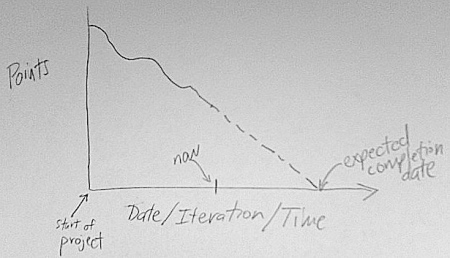When you've got a to-do list in your head, with no consistency or order, that's what a co-worker of
mine yesterday called planning soup. Dip the ladle in the pot and whatever comes out is the next task
for you to tackle.
Planning Soup is manageable for lone developers working on a single project at a time. It's probably
still warm and tasty even for the lone coder working on a few projects at a time. He knows what features need
to be developed, in what order, and by what date. Some people can't work that way, I understand. But the
lack of ceremony around the planning process can allow the others to thrive.
When you have multiple many-to-many relationships between programmers and projects, however, that
delicious tomato basil soup starts to uglify.

"How long will it take you to finish new Project Bamtastico?" asks the bossman.
"I'm working on Project Shinsakenam at the moment. So probably a couple of weeks," you reply.
Later the same day, one of your teammates tells you about some soup that just went into his cup. As it happens,
his cup was already full: the project is due tomorrow, and he needs help. It's higher priority than both
Bamtastico and Shinsakenam, so you've got to help it be as little late as possible.
Extrapolate what happens to your projects, and everyone else's.
You need something more structurable than soup to aid in your planning.
You may not not need the filet mignon formality of project planning software and paper document legalese,
but you need
something more structured than soup. With soup, some team members don't know what
others have done or are doing. They may not know what needs to be done. They may be unaware of entire
projects. (While that's expected in large organizations, it can be bad! in small ones.)

I might recommend the firm, yet flexible approach of jello. Get the developers together in a room.
List the projects and features on a whiteboard. Use different colors to give a rough indication of which
tasks can be performed by the same person.
You need to start measuring. You don't have to measure much, but you need to assign costs to features and
track how much of the total cost you can complete in some time frame. After some larger time frame, you'll
be able to give accurate completion dates for the outstanding projects, as well as any new ones that crop up.

Give each project its own
BFC,
of the burndown variety. Seriously, it'll take like 10 minutes to keep this stuff updated. Start crossing out
features as they're consumed.
It's not as free-form as soup, but it might do you some good.
Hey! Why don't you make your life easier and subscribe to the full post
or short blurb RSS feed? I'm so confident you'll love my smelly pasta plate
wisdom that I'm offering a no-strings-attached, lifetime money back guarantee!
Leave a comment
What is that abomination you call soup? Looks like a chicken's hand with a fish coming out of it....
Posted by Icarus
on Jan 04, 2012 at 04:44 PM UTC - 5 hrs
Not sure what it is to be honest.
Posted by
Sammy Larbi
on Jan 04, 2012 at 05:42 PM UTC - 5 hrs